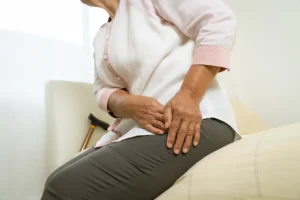After hip replacement surgery, most people wonder, “how long after hip replacement can I tie my shoes?” Typically, this can happen in about 6 to 8 weeks. This guide will explain what affects your recovery timeline and offer tips to help you get back to normal activities.
Key Takeaways
- Patients typically require 6 to 8 weeks post-surgery to tie their shoes independently, depending on individual recovery factors.
- Adhering to hip precautions and following a prescribed physical therapy plan are important for a safe and effective recovery process after hip replacement.
- Tools such as long-handled shoehorns, slip-on shoes, and elastic shoelaces can facilitate the process of dressing independently during recovery.
How Long After Hip Replacement Can I Tie My Shoes? Recovery Tips & Advice
Patients typically need about 6 to 8 weeks after hip replacement surgery before they can start tying their shoes independently. This timeline can vary depending on individual recovery rates and adherence to post-operative guidelines. Recovery is a gradual process that requires patience and dedication.
Most patients can resume regular activities within two to three months post-surgery, but the ability to tie shoes specifically can be influenced by the level of flexibility and strength regained. Each patient’s journey is unique, and factors such as age, overall health, and adherence to physical therapy can significantly impact the recovery timeline.
Following hip precautions during this period helps to avoid complications like hip dislocation. Using the right strategies and tools can facilitate the process of tying shoes without risking your new hip.
Introduction
Anterior hip replacement surgery is known to significantly enhance mobility and overall quality of life by eliminating chronic pain that restricts daily activities. This hip replacement procedure can allow patients to return to a more active and fulfilling lifestyle, often resuming activities they once enjoyed without discomfort.
Proper preparation before surgery contributes to a smoother recovery process. This includes understanding the importance of following post-operative guidelines, which are tailored to minimize the risk of complications and support the healing process. Being well-prepared can make a significant difference in how quickly and effectively patients can regain their independence.
Timeline for Tying Shoes Post-Hip Replacement
The journey to tying your shoes post-hip replacement is a gradual one, typically spanning 6 to 8 weeks. This timeline is influenced by various factors, including the extent of your surgery, your overall health, and how diligently you follow the prescribed recovery plan. During this period, specific strategies and tools can help ease the process and ensure you avoid complications.
First Few Weeks
In the first few weeks following hip replacement surgery, it’s essential to take guidance from your orthopedic surgeon or physical therapist before attempting any activities. Moving too much or too soon can lead to increased muscle pain or even complications such as hip dislocation. Therefore, avoiding bending during the initial healing process is crucial to ensure proper recovery.
Two weeks post-surgery, many patients can begin to stand at a kitchen counter without aid, signaling the return of some independence. However, when sitting, it’s important to keep your hips and knees positioned at 90 degrees, with the knees below the hips, to minimize strain.
During the first 6 weeks, avoid low chairs and sofas to prevent excessive bending that could jeopardize your recovery.
6–8 Weeks Post-Surgery
Around 6 to 8 weeks post-surgery, you may start to tie your shoes as your recovery progresses. By this time, many patients have regained sufficient flexibility and strength to manage this task independently. However, continue following your surgeon’s advice and attend follow-up appointments to stay on track with your recovery.
Follow-up appointments are crucial during this period to monitor your recovery status and make any necessary adjustments to your rehabilitation plan. These visits help ensure that you’re ready to resume various activities safely and effectively.
Individual Recovery Variances
Recovery times after hip replacement surgery can differ significantly from one patient to another. Factors such as individual health conditions, age, and previous activity levels play major roles in how quickly you can resume daily activities like tying shoes.
Understanding these variances is crucial for setting realistic expectations for your recovery journey. Following post-operative protocols, including physical therapy and activity restrictions, can significantly impact your progress. Ultimately, patience and consistency are key to a successful recovery.
Importance of Following Hip Precautions
Adhering to hip precautions is vital to prevent complications such as hip dislocation and ensure proper healing. These precautions involve limiting certain movements and activities that could jeopardize your recovery.
Following these guidelines is key for a safer and more effective rehabilitation process.
Avoid Bending at the Waist
Bending at the waist is a significant risk factor that could lead to complications during the recovery process after hip replacement surgery. Activities like sitting in a low chair or tying shoes should be avoided to prevent dislocation. Caution is crucial during recovery to avoid undoing any surgical progress and to ensure a safe healing process.
Avoid specific activities, such as crossing legs and lean forward while sitting, to prevent strain on the hip joint. Maintaining these precautions helps in promoting a safer and more effective recovery.
Use of Mobility Aids
Mobility aids such as crutches, walkers, or canes are commonly used during early recovery after hip replacement surgery. Long-handled shoe horns, which range from 18 to 32 inches in length, can facilitate the process of putting on shoes without requiring you to bend at the waist, thereby promoting safer recovery.
Recommended Physical Therapy Exercises
Physical therapy exercises play a crucial role in the recovery process after hip replacement surgery. These exercises rebuild muscle strength, increase flexibility, and restore range of motion.
Starting physical therapy as soon as possible after surgery is essential for enhancing recovery and managing pain.
Strengthening Hip Muscles
Exercises like straight leg raises and buttock contractions can significantly aid in rebuilding strength around the hip joint. These exercises focus on building strength in the muscles supporting the hip joint, which is crucial for recovery post-surgery.
Begin with one set of 10-15 repetitions and gradually progress to three sets to enhance muscle strength and support mobility.
Increasing Flexibility
Stretching plays a crucial role in enhancing flexibility, which in turn eases daily movements like tying shoes. To stretch effectively, hold each stretch for 45 seconds and repeat multiple times a day.
Incorporating stretching into your routine can significantly improve your ability to tie your shoes post-surgery.
Guided Physical Therapy Sessions
Personalized exercise plans created during guided physical therapy sessions significantly contribute to effective rehabilitation. Working closely with a physical therapist ensures that exercises are tailored and monitored for safety and effectiveness during recovery.
Engaging in these guided sessions helps ensure that exercises are conducted safely and contribute to a successful recovery process.
Managing Pain and Mobility Issues
Managing pain and mobility issues is a critical aspect of the recovery process after hip surgery. Starting physical therapy exercises soon after surgery can enhance recovery and minimize pain.
Incorporate strategies for managing pain effectively and improving mobility safely to ensure a smooth recovery.
Pain Management Techniques
Medications, such as over-the-counter pain relievers and prescribed medications, can help play a helpful role in managing pain post-hip replacement. Additionally, alternative therapies, including physical therapy techniques such as acupuncture and massage, can be effective in managing pain and enhancing mobility.
These techniques, combined with consistent physical therapy exercises, contribute to a comprehensive pain management strategy and support the overall healing process.
Improving Mobility Safely
Using assistive devices like crutches or walkers helps alleviate weight on the surgical site, easing pain during recovery. Implementing the RICE method—rest, ice, compression, and elevation—can significantly reduce discomfort after weight-bearing activities.
Starting with short walks can also aid in the recovery of mobility after hip replacement surgery. These methods, along with consistent physical therapy exercises, ensure that mobility improves safely and effectively.
Suggested Equipment for Easier Shoe Tying
Using specific equipment can significantly aid individuals recovering from hip replacement surgery in tying their shoes without needing to bend down. These tools, such as slip-on shoes, long-handled shoehorns, and elastic shoelaces, contribute to a more comfortable recovery experience by allowing patients to dress independently and safely.
Slip-On Shoes
Slip-on shoes are highly recommended during recovery as they eliminate the need for bending over, making them easier to wear post-surgery. Wear slip-on shoes can greatly enhance comfort and convenience during recovery by eliminating the need to bend down.
These shoes offer a practical solution that supports safe and independent dressing during recovery.
Long-Handled Shoe Horns
Long-handled shoe horns help individuals avoid bending, making it easier to put on shoes after hip replacement. To use a long-handled shoe horn, slide the horn into your shoe before stepping into it, ensuring your foot fits in without bending.
Choose a long-handled shoe horn that is sturdy, has a comfortable grip, and is long enough to prevent bending at the waist.
Elastic Shoelaces
Elastic shoelaces allow users to keep their shoes tied without the need for traditional knot-tying techniques, providing great convenience. They reduce the need to bend over, making them particularly suitable for individuals recovering from hip replacement surgery.
These shoelaces are adjustable, allowing wearers to customize the tightness for comfort and support. Elastic shoelaces promote independence, allowing individuals to put on and take off their shoes with ease.
Preparing for Normal Activities
Full recovery from hip replacement surgery can take between 6 to 12 months. Patients often require time to return to daily activities. Being an active participant in the healing process is necessary for a more successful outcome after hip replacement.
Tools like elastic shoelaces and slip-on shoes can significantly simplify the process of putting on shoes after surgery.
Gradual Increase in Activity Levels
Gradually increasing activities is important for patients as their body gets stronger after hip replacement. This gradual approach ensures that the body can adapt to increasing demands without risking complications.
Following the physical therapy plan carefully helps to safely increase activity levels over time.
Monitoring Progress
Regularly assessing progress allows for adjustments to activities according to recovery stages. Regular assessments ensure safe activity levels are maintained during recovery. Adjusting activities based on these evaluations enhances safety and effectiveness in regaining mobility.
Follow-Up Appointments
Regular follow-ups with healthcare providers are essential to monitor recovery status and adjust activity levels. These appointments help determine a patient’s readiness to engage in more demanding activities. They also address any concerns or complications that may arise during recovery.
Summary
Recovering from hip replacement surgery involves a careful balance of following hip precautions, engaging in physical therapy exercises, and using adaptive equipment to regain independence. Patients should expect a gradual recovery process, typically spanning 6 to 8 weeks before they can comfortably tie their shoes again. Adherence to guidelines, regular progress monitoring, and the use of mobility aids are crucial for a successful recovery. By being patient and proactive in their rehabilitation, patients can look forward to resuming their daily activities with improved mobility and reduced pain.
Frequently Asked Questions
How long after hip replacement can I tie my shoes?
You can typically expect to tie your shoes independently about 6 to 8 weeks after hip replacement surgery, depending on your recovery. Always consult with your orthopedic surgeon for personalized guidance.
What precautions should I take to avoid hip dislocation after surgery?
To avoid hip dislocation after surgery, avoid bending at the waist beyond 90 degrees, crossing your legs, and sitting in low chairs. Utilize mobility aids such as long-handled shoe horns to help minimize bending movements.
What types of exercises are recommended after hip replacement surgery?
After hip replacement surgery, it’s essential to engage in physical therapy exercises like straight leg raises, buttock contractions, and various stretching exercises to strengthen the hip muscles and enhance flexibility. Prioritizing these activities will aid in your recovery and improve mobility.
How can I manage pain effectively after hip surgery?
To effectively manage pain after hip surgery, utilize a combination of prescribed medications, explore alternative therapies such as acupuncture and massage, and engage in consistent physical therapy exercises. This holistic approach will help ensure a smoother recovery process.
What equipment can help with tying shoes during recovery?
Using slip-on shoes, long-handled shoe horns, and elastic shoelaces can greatly assist in tying shoes during recovery, allowing you to avoid bending. These tools can enhance comfort and convenience as you heal.





